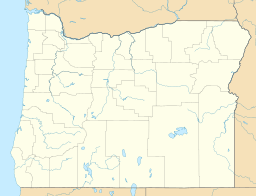Crooked River caldera facts for kids
Quick facts for kids Crooked River caldera |
|
|---|---|
| Highest point | |
| Geography | |
| Location | Deschutes, Crook, and Jefferson counties, Oregon, U.S. |
| Geology | |
| Age of rock | 29.5 Ma |
| Mountain type | Caldera |
The Crooked River caldera is a huge, ancient volcano in central Oregon, U.S.. It's so big it stretches across three different counties: Deschutes, Crook, and Jefferson.
A caldera is like a giant bowl-shaped hollow. It forms when a volcano erupts and then collapses in on itself. This caldera is about 41 kilometers (25 miles) long and 27 kilometers (17 miles) wide. Scientists believe the Crooked River caldera is an extinct volcano. This means it's not expected to erupt again. Its last eruption happened around 29.5 million years ago. That's a very long time!
Contents
What is a Caldera?
A caldera is a large, basin-shaped hole in the ground. It forms after a huge volcanic eruption. When a volcano erupts, it empties its magma chamber. This chamber is a big underground space filled with molten rock.
After the magma is gone, the ground above the chamber loses its support. It then collapses downwards, creating a large depression. This depression is what we call a caldera. They can be many kilometers wide.
How Calderas Form
Calderas form in a specific way. First, a volcano has a massive eruption. This eruption sends out a lot of ash, gas, and rock. This material comes from the magma chamber below.
Once the magma chamber is mostly empty, the roof of the chamber becomes unstable. It can no longer support the weight of the ground above it. So, the ground collapses inward. This collapse creates the large, circular or oval-shaped depression.
Types of Volcanoes and Calderas
Not all volcanoes form calderas. Calderas usually form from stratovolcanoes or shield volcanoes that have very explosive eruptions. The Crooked River caldera is an example of such a feature.
Some calderas can even fill with water over time. This creates beautiful caldera lakes. A famous example is Crater Lake in Oregon.
The Crooked River Caldera's History
The Crooked River caldera is very old. It formed about 29.5 million years ago. This was during a time period called the Oligocene epoch. Back then, the landscape of Oregon looked very different.
Scientists study the rocks around the caldera to learn about its past. They find special rocks called welded tuff. Welded tuff is a type of rock formed from volcanic ash. This ash was so hot when it landed that it fused together.
Where to Find Welded Tuff
You can find this welded tuff in several places around the Crooked River caldera. These locations include Gray Butte, Smith Rock, and Powell Buttes. You can also find it at Grizzly Mountain and Barnes Butte.
These rock formations help scientists understand the size and power of the ancient eruption. They show how far the volcanic material spread.
Why is the Crooked River Caldera Important?
The Crooked River caldera is important for several reasons. It helps scientists understand Earth's history. Studying it teaches us about past volcanic activity in Oregon. It also shows how landscapes change over millions of years.
Geological Significance
This caldera is a key part of Oregon's geology. It provides clues about the forces that shaped the region. It also helps us learn about the types of rocks found there.
The caldera's size and age make it a unique geological feature. It's a natural laboratory for studying ancient volcanoes.
Natural Beauty and Recreation
Even though it's an ancient volcano, the area around the caldera is beautiful. Places like Smith Rock State Park are popular for outdoor activities. People enjoy rock climbing, hiking, and sightseeing there.
These areas offer stunning views of the landscape. They also let people see the results of ancient volcanic activity up close.
Is the Crooked River Caldera Still Active?
The Crooked River caldera is considered an extinct volcano. This means it is no longer active. Scientists do not expect it to erupt again.
Volcanoes are classified as active, dormant, or extinct. An active volcano has erupted recently or is expected to erupt soon. A dormant volcano has not erupted for a long time but could erupt again. An extinct volcano is one that scientists believe will never erupt again.
Monitoring Volcanoes
Scientists constantly monitor volcanoes around the world. They use special equipment to detect changes. This includes tracking ground movement and gas emissions.
This monitoring helps them predict eruptions. It keeps people safe in areas near active volcanoes. Since the Crooked River caldera is extinct, it does not need this kind of monitoring.


